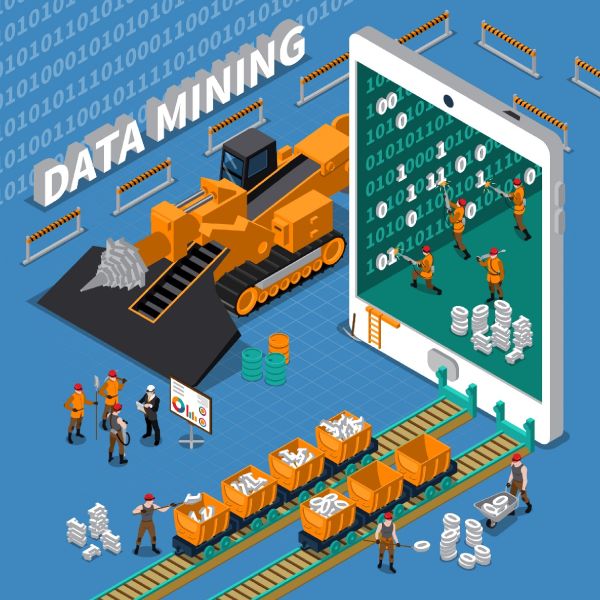Today, your management cannot compete with market challenges without data. One of the most important tasks for today’s entrepreneurs is to become more data-driven. But how do you do it? It all begins with a procedure known as data mining.
Big data, digital transformation, and data analytics process … None of this is new on the technexon blog, and we constantly talk about and use these innovations.
However, inside the data, there lies an universe of possibilities that organisations frequently overlook. For that, various actions must be followed in order to achieve this. Data manipulation is a difficult task, but the data mining method makes it easier.
In this complete guide, we will explain everything about data mining, going through the following topics:
- What is Data Mining?
- How important is data mining?
- How does data mining work?
- In which sectors is data mining present?
- Data mining steps
- Data mining techniques used by companies
- What are the primary tools for data mining?
- Big data and data mining: how are they related?
- What is the relationship between data mining and Artificial Intelligence?
- Mining your company’s data
Table of Contents
What is data mining (data mining)?
Data mining is an automated method of exploring massive volumes of data for patterns that people cannot see with the naked eye. Artificial intelligence, machine learning, and statistics are used to do this.
The goal is to uncover patterns, correlations, and even anomalies that may be used to anticipate future outcomes. Data mining is not the same as “extracting fresh data” from a database, despite the name. In practise, it refers to a thorough examination of an existing database in order to uncover facts, trends, and insights critical to your company objectives.
Data mining enables the development of models and algorithms that can more accurately forecast certain events.
The origin of data mining
Data mining was an idea that existed long before computers were invented. It’s an ancient notion, but it can be traced back to Bayes’ Theorem, a mathematical formula that determines the conditional probability of an occurrence, which was published in 1763.
However, several advances that transformed the technical level in the previous century gave rise to the present perspective on the issue.
The Universal Turing Machine of 1936, the discovery of Neural Networks in 1943, the development of databases in the 1970s, and further database breakthroughs in the early 1990s are just a few examples.
Over the next few decades, processors, databases, and technologies advanced. In all applications, data mining has gotten more powerful and efficient.
How Important is Data Mining?
Data mining is critical to a company’s strategic growth because it allows it to better understand customer behaviour and market trends in a more contextualised and accurate manner.
With this, it is possible:
- detect trends;
- predict various outcomes;
- model your target audience;
- collect information about the use of the product/service;
You can adjust rapidly, upgrading your product or service offerings to produce good outcomes, by knowing the factors that impact consumer behaviour and decisions.
Furthermore, you may gain insights that will assist you in analysing, understanding, and removing all superfluous data from your database.
Thus, it is possible to improve your decision-making process continuously.
How Does Data Mining Work?
But what is data mining’s practical application? Is it applicable to all types of businesses? To begin, it’s important to recognise that this strategy is successful in achieving a corporate objective, answering inquiries, or contributing to a problem-solving solution.
Data mining aids in accurate prediction, pattern recognition, and anomaly detection… But how do you do it?
The technique of how data mining works, on the other hand, is possibly the most complicated in this introduction to the subject, because it necessitates knowledge of the complete data processing system.
The phases vary depending on the literature, however the five steps below adequately depict how the data mining process works:
Collect Data
Data is collected, organized, stored, and managed on internal servers or the cloud.
Understanding The Data
Analysts and data scientists will look at the most basic aspects of data, which will be picked based on the company’s challenges, queries, and objectives. This process verifies the data sources and determines which attributes are the most critical.
Data Preparation
After data sources have been committed, they must be cleaned up and formatted in the manner required.
Data Modeling
Modeling strategies are used to process the chosen data in data modelling. The goal is to look for patterns, correlations, and anomalies.
A data model is a graphic that depicts the connections between different types of data in a database. The most operational stage in the data mining process is this.
Data Evaluation
Finally, the model’s output is compared to the company’s goals. After all, how will the data gathered benefit the company?
Who Works with Data Mining?
Mining appears to be (and is) a very sophisticated and demanding profession. It is an activity that has been slowly expanding among certain professional domains in today’s industry. Between them, they are:
computer scientists: Data mining is used by computer scientists who are in charge of developing new technologies (programming languages, operating systems, and software in general).
Market Researchers and Analysts: Conduct marketing research to assist businesses in attracting new consumers, increasing sales, and determining the viability of new goods.
Network Architects: Network Architects are responsible for designing, constructing, and maintaining a company’s data transmission network. Mining can help them enhance network speed while lowering expenses.
Security Analysts: They employ mining to find abnormalities in their programmes and antivirus to secure the IT infrastructure and data architecture.
In Which Sectors is Data Mining Present?
Anyone who believes that data mining is only employed in IT firms and other comparable purposes is mistaken.
This method aids firms in identifying process flaws and faults, such as supply chain bottlenecks or simply insufficient data entry, which contaminates their analysis.
Next, look at the industries that make use of data mining.
Health Industry
Data mining may be used in the health field to search medical datasets for connections between symptoms and individual attributes.
As a result, illnesses may be predicted and patients can be alerted to the likelihood of their occurrence, allowing them to focus on their cure or the best treatment option.
Retail Industry
Understanding consumer habits, preferences, and decisions is one of the most common uses of data mining in retail.
How? Data mining technologies analyse purchase history to reveal your preferences and help retailers better understand how to arrange things on shelves and which products and brands to offer in promotions or special discounts.
Furthermore, data mining may be utilised in e-commerce to enhance product recommendations by improving upsell and cross-selling.
Education Industry
In educational research, data mining is utilised to better understand the elements that drive the behaviours that hinder your learning.
Telecommunications
The weather prediction is a superb example of a data mining application in telecoms that we all utilise on a regular basis.
This step may be conducted via data mining, which analyses previous data to find trends and forecast future weather conditions depending on the time of year, weather, and other characteristics.
Banking and Finance
Banks gather a lot of personal information and spending history from their clients, and a customer’s whole financial life might be maintained in a database.
It’s quality data, but it has to be analysed quickly and thoroughly. As a result, there are several applications of data mining in banks and financial organisations.
The credit analysis used to authorise loans is one of them.
The bank can use data mining techniques to assess the customer’s payment history and key parameters like payment rate, credit history, loan duration, and so on to determine whether the credit can be accepted.
Furthermore, these instruments can aid in the detection of financial crimes. When examining and identifying anomalous trends, such as high-value transactions, for example, informing the appropriate authority is one example.
Manufacturing Industry
Data mining may be used in manufacturing to assess productive data and quality data for each made product.
As a result, it is feasible to examine and identify trends that impact time and production flow, as well as the final product’s quality.
This connection can offer a number of advantages, including allowing those in charge of assessing previously invisible problems to take financial action (which is worthwhile versus not).
Insurance Sector
Data mining technologies in the insurance sector allow organisations better study clients who buy policies, examine facts and papers (such as physicians), and analyse behaviours to define values, predict dangerous customers, and even avoid fraud.
Human Resources
In Human Resources, data mining is critical for making better decisions, increasing employee happiness, and optimising procedures like online recruiting, all of which provide value to the firm.
You may measure the absence rate according to their characteristics when you have the correct collection of employee data, such as age, cultural, and regional information. This allows you to improve your recruiting process.
Data Mining Steps
As previously said, the data mining process is quite complicated, which means that each stage presents a unique set of obstacles for those engaged.
Yes, tools and technology for gathering, storing, and analysing data are necessary, but ethical professionals must also do a lot more.
Why don’t you double-check? Take a look:
Define Data Mining Goal
First, every data mining action is determined following a goal. Often, it may just be clarifying a performance indicator. Others answer a specific question whose answer is challenging to find, such as:
“Whydidn’t our new release convince customers and not reach 45% market share as we had hoped? “.
It’s a question that a simple survey rarely answers – but data does! As a result, data mining should always be carried out with a specific aim in mind.
Delete duplicate information
Eliminating duplicate data is one of the operational processes required in data mining. Once the data sources have been identified, stakeholders must examine the data for duplication.
It’s common for several data sets to exhibit the same information, which might pollute and slow down the research process.
To improve the accuracy of the reading, a comprehensive study of the data is required at this stage.
Clear data that is not useful
Furthermore, data sources frequently provide far more information than is required. This means that your tool will not always make use of all of the information gathered.
In this regard, one of the mining procedures is to clean, removing duplicates and irrelevant data for the task at hand.
Perform Data Mining
Finally, data mining follows the five phases outlined previously in this article: collection, comprehension, preparation, modelling, and assessment.
Tools are critical in this process since they provide resources and the capacity to undertake research and create results with only a few clicks.
Data Mining Techniques Used by Companies
One of the most important things to remember about data mining is that, despite the structure we learn throughout the content, it may be used in a variety of ways.
Through data mining techniques. These best practices originated with knowledge of database management, machine learning, statistics, and artificial intelligence.
How about knowing the main ones? Check out!
Forecast
One of the most useful data mining techniques is forecasting. It’s used to produce forecasts, displaying facts that will be seen in the future. This method employs predictive analytics, which extends current or past data trends into the future.
As a result, it provides enterprises with insight into what patterns may emerge in their data in the future. Machine learning, artificial intelligence, and basic or complicated algorithms can all be used in this method. In practise, we discuss recognising behaviours in order to comprehend previous trends and make an accurate forecast of what will occur in the future.
Association or relationship
The association technique is linked to the event’s statistic. It aims to figure out whether data (or data-driven events) are related to other data (or data-driven events).
It’s a notion with various complications in theory, and it’s analogous to the statistical idea of correlation. This strategy, on the other hand, explores the data for a link between two occurrences to make things simpler.
Let’s look at few examples. In fast food, association data mining can reveal that a hamburger order is accompanied by medium fries and a medium Coke in 73% of cases. It’s a method of looking for certain occurrences or traits that are strongly linked to another event or fact.
For example, this type of analysis encourages the “people also bought” section in e-commerces.
Decision Tree
A form of prediction model known as decision trees. This method allows you to respond to specific questions. It’s a visual model that shows stakeholders how data inputs influence outputs.
It’s a question with a variety of replies. You may answer the question in a variety of ways based on your data and previous trends, anticipating client behaviour and finding solutions to problems.
Classification
Classification is a technique that combines several different techniques, such as decision trees and neural networks. It is based on the categorization of information or objects. The goal is to correctly forecast an item’s categorization in relation to a request.
The rating, for example, is used to classify borrowers as having a low, medium, or high credit risk. This method employs a complicated attribute analysis approach that checks several data kinds regarding the individuals involved.
Once the main characteristics of the data are classified, it is possible to categorize them, making decision-making more straightforward and more intuitive.
Sequential Patterns
With sequential patterns, it is feasible to identify a set of occurrences that occur in order. for example, It can assist a fashion store in determining which clothes items clients are most likely to buy after making an initial purchase, like as a pair of shoes.
These patterns may be used to better organise upsell and cross-selling actions, but they can also be used in a variety of other circumstances. For example, Sequential patterns might reveal that the change of season is linked to a greater rate of product purchases in a specific category.
Analyzing sequential patterns will improve your organisation by allowing you to plan activities more effectively.
Clustering
Finding objects or occurrences in the same dataset with comparable qualities that may be grouped into the same class is referred to as clustering.
It’s similar to categorization, but the grouping is more adaptive to changes and aids in highlighting important characteristics that define distinct groupings.
What are the Most Common Data Mining Tools?
Large data volumes are difficult to process and analyse, and they are impossible to do without the aid of sophisticated technologies. Different approaches and procedures have their own set of tools.
We address AI, machine learning, predictive analytics, and other elements broadly utilized in data mining throughout this tutorial.
What if you knew some of the most commonly used tools in data mining? Take a look!
Rapid Miner
The open source technology is used for predictive analytics and allows organizations to carry out deep learning actions, mining text documents with machine learning and other techniques.
Its modules enable prototyping and validation, the creation and operation of data models, and the execution of cluster activities.
Oracle Data Mining
Oracle, the world’s leading database software company, combines its database expertise with analytic tools. It includes classification, regression, prediction, anomaly detection, and other data mining methods. This is proprietary software that is maintained by Oracle technical team in order to assist your company in establishing a comprehensive data mining infrastructure at the enterprise level.
KNIME
KNIME, which is also open source, is an integration platform that uses integrated machine learning and data mining to do data analysis and Business Intelligence reporting. It also enables data models to be deployed and scaled quickly.
Other tools
Overall, a large range of tools may be employed due to the different methodologies available.
It’s worth emphasising that businesses must follow compliance and LGPD requirements while analysing and manipulating data, fostering appropriate IT governance practises.
It’s also a critical tool for centralising and facilitating data visualisation so that analytical procedures are more transparent.
Big data and data mining: how are they related?
Big data and data mining have a very strong link. The first asks, “What?” whereas the second asks, “How?”
Big Data is huge dataset we’ve covered throughout the tutorial. It’s the primary source of data from which your team takes the most pertinent information for analysis.
Data mining, on the other hand, is the close examination — the above-mentioned analysis — that strives to grasp the whys.
Big data is a larger view of data, whereas mining is focused with sifting through it in search of a “how” or “why.”
What are the similarities and differences between data mining and artificial intelligence?
Artificial intelligence and data mining have a long-standing link. Yes, there is a link between the two. How about trying to comprehend it?
Artificial intelligence is a field dedicated to developing intelligent solutions that can function in the same way as people do, whether they be machines, robots, or software.
The “purest” AI solutions do not rely on learning or feedback, but instead feature control systems that are explicitly written. Through computations and algorithms, AI systems provide answers to issues on their own.
In this situation, data mining is used by AI solutions and systems to find answers to their challenges. It is, in other words, one of AI’s cornerstones.
Mining your company’s data
Have you begun working on your data mining strategy, tools, and environment at your company?
It may not seem required right now, but it’s an important mindset to have in the medium and long term if you want your business to stand out.
Data mining allows you to enhance a number of aspects of your business that were previously difficult to improve.
Pricing services and goods, for example, provides for a more in-depth examination of the factors that impact prices, such as demand, elasticity, logistical capacity, and brand perception. Furthermore, data mining aids in the improvement of marketing decisions, client retention, and brand reach.
Another benefit of data mining is that it allows for a more thorough examination of an employee’s experience throughout their employment cycle.
As a result of interpreting all of the behaviour patterns, improved human capital management strategies may be developed, resulting in a better employee experience.
Business Intelligence Platforms
A business intelligence system is one of the most important instruments for establishing a data-driven culture in your company.
BI is a comprehensive tool for assessing market data, your company, and your customers. You may extract valuable insights that will help you steer business choices using great resources such as dashboards and indicators that make it easy to understand your company’s performance.
Your business may use a BI platform to connect data, investigate the possibilities of big data, process information, manage insight input, and execute all governance for better information security.
Final Opinion
When your firm begins to use the full potential of big data, one of the pillars to attain is data mining. It’s one of the most basic approaches in contemporary business, allowing a company to rely on data to enhance its operations.



